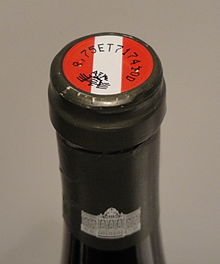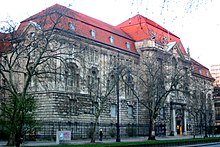
Liebfraumilch or Liebfrauenmilch is a style of semi-sweet white German wine which may be produced, mostly for export, in the regions Rheinhessen, Palatinate, Rheingau, and Nahe. The original German spelling of the word is Liebfrauenmilch, given to the wine produced from the vineyards of the Liebfrauenkirche or "Church of Our Lady" in the Rhineland-Palatinate city of Worms since the eighteenth century. The spelling Liebfraumilch is more common on labels of exported wine.

Ice wine is a type of dessert wine produced from grapes that have been frozen while still on the vine. The sugars and other dissolved solids do not freeze, but the water does, allowing for a more concentrated grape juice to develop. The grapes' must is then pressed from the frozen grapes, resulting in a smaller amount of more concentrated, very sweet juice. With ice wines, the freezing happens before the fermentation, not afterwards. Unlike the grapes from which other dessert wines are made, such as Sauternes, Tokaji, or Trockenbeerenauslese, ice wine grapes should not be affected by Botrytis cinerea or noble rot, at least not to any great degree. Only healthy grapes keep in good shape until the opportunity arises for an ice wine harvest, which in extreme cases can occur after the New Year, on a northern hemisphere calendar. This gives ice wine its characteristic refreshing sweetness balanced by high acidity. When the grapes are free of Botrytis, they are said to come in "clean".

German wine is primarily produced in the west of Germany, along the river Rhine and its tributaries, with the oldest plantations going back to the Roman era. Approximately 60 percent of German wine is produced in the state of Rhineland-Palatinate, where 6 of the 13 regions (Anbaugebiete) for quality wine are situated. Germany has about 103,000 hectares of vineyard, which is around one tenth of the vineyard surface in Spain, France or Italy. The total wine production is usually around 10 million hectoliters annually, corresponding to 1.3 billion bottles, which places Germany as the eighth-largest wine-producing country in the world. White wine accounts for almost two thirds of the total production.

The German wine classification system puts a strong emphasis on standardization and factual completeness, and was first implemented by the German Wine Law of 1971. Nearly all of Germany's vineyards are delineated and registered as one of approximately 2,600 Einzellagen, and the produce from any vineyard can be used to make German wine at any quality level, as long as the must weight of the grapes reaches the designated minimum level. As the current German system does not classify vineyards by quality, the measure of wine ’quality’ is the ripeness of the grapes alone.

Spätlese is a German wine term for a wine from fully ripe grapes, the lightest of the late harvest wines. Spätlese is a riper category than Kabinett in the Prädikatswein category of the German wine classification and is the lowest level of Prädikatswein in Austria, where Kabinett is classified in another way. In both cases, Spätlese is below Auslese in terms of ripeness. The grapes are picked at least seven days after normal harvest, so they are riper and have a higher sugar content. Because of the weather, waiting to pick the grapes later carries a risk of the crop being ruined by rain. However, in warm years and from good sites much of the harvest will reach Spätlese level.
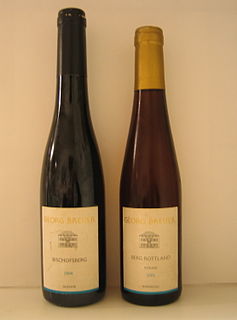
Auslese is a German language wine term for a late harvest wine and is a riper category than Spätlese in the Prädikatswein category of the Austrian and German wine classification. The grapes are picked from selected very ripe bunches in the autumn, and have to be hand-picked. Generally Auslese wine can be made in only the best harvest years that have been sufficiently warm. A small proportion of the grapes may be affected by noble rot in some regions although this never dominates the character of the wine. Rheingau winemaker Schloss Johannisberg is generally credited with discovering Auslese wine in 1787.
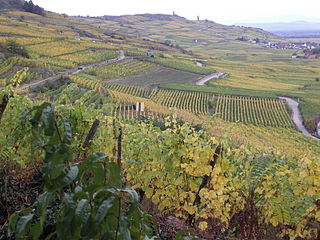
Alsace wine or Alsatian wine is produced in the Alsace region in France and is primarily white wine. Because of its Germanic influence, it is the only Appellation d'Origine Contrôlée region in France to produce mostly varietal wines, typically from similar grape varieties to those used in German wine. Along with Austria and Germany, it produces some of the most noted dry Rieslings in the world as well as highly aromatic Gewürztraminer wines. Wines are produced under three different AOCs: Alsace AOC for white, rosé and red wines, Alsace Grand Cru AOC for white wines from certain classified vineyards and Crémant d'Alsace AOC for sparkling wines. Both dry and sweet white wines are produced.
A diluent is a diluting agent. Certain fluids are too viscous to be pumped easily or too dense to flow from one particular point to the other. This can be problematic, because it might not be economically feasible to transport such fluids in this state. To ease this restricted movement, diluents are added. This decreases the viscosity of the fluids, thereby also decreasing the pumping/transportation costs.

Diethylene glycol (DEG) is an organic compound with the formula (HOCH2CH2)2O. It is a colorless, practically odorless, and hygroscopic liquid with a sweetish taste. It is a four carbon dimer of ethylene glycol. It is miscible in water, alcohol, ether, acetone, and ethylene glycol. DEG is a widely used solvent. It can be a contaminant in consumer products; this has resulted in numerous epidemics of poisoning since the early 20th century.
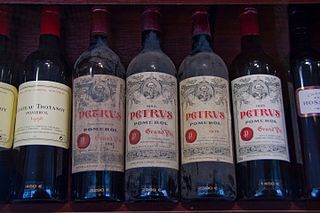
Wine fraud relates to the commercial aspects of wine. The most prevalent type of fraud is one where wines are adulterated, usually with the addition of cheaper products and sometimes with harmful chemicals and sweeteners.
The glossary of wine terms lists the definitions of many general terms used within the wine industry. For terms specific to viticulture, winemaking, grape varieties, and wine tasting, see the topic specific list in the "See also" section below.

The United Kingdom is a major consumer of wine, but a minor though growing producer. Wine production in the UK has historically been perceived as less than ideal due to the cold climate, but warmer summers and grapes adapted to these conditions have played a role in increasing investment and sale of wines. Most is English sparkling wine, from vineyards across Southern England and sparkling wine from Wales where the climate is warmer than that of northern areas. Vineyards are becoming more commonplace in counties such as Essex, Sussex and Kent, where more varieties of wine can be produced due to the drier and warmer climate.

Austrian wines are mostly dry white wines, though some sweeter white wines are also produced. About 30% of the wines are red, made from Blaufränkisch, Pinot noir and locally bred varieties such as Zweigelt. Four thousand years of winemaking history counted for little after the "antifreeze scandal" of 1985, when it was revealed that some wine brokers had been adulterating their wines with diethylene glycol. The scandal destroyed the market for Austrian wine and compelled Austria to tackle low standards of bulk wine production, and reposition itself as a producer of quality wines. The country is also home to Riedel, makers of some of the most expensive wine glasses in the world. Some of the best producers of Austria include Weingut Bründlmayer, Weingut F.X. Pichler and Weingut Franz Hirtzberger, Weingut Hutter, Weingut Eigl and Wellanschitz.
Since the 1990s, several mass poisonings from toxic cough syrup have occurred in developing countries. In these cases, an ingredient in cough syrup, glycerine (glycerol), was replaced with diethylene glycol, a cheaper alternative to glycerine for industrial applications. Diethylene glycol is nephrotoxic and can result in multiple organ dysfunction syndrome (MODS), especially in children.
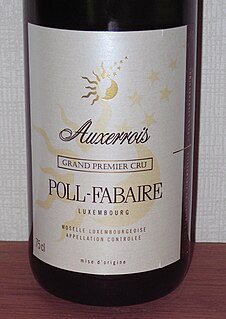
Luxembourg wine is primarily produced in the southeastern part of the Grand Duchy of Luxembourg, with vineyards overlooking the river Moselle. Along this river, which for 42 km makes up part of the border between Luxembourg and Germany, wine is made in three countries. There is a continuous history of winemaking along Moselle and in Luxembourg going back to Ancient Roman times. Wine production in 2006/07 was 123,652 hectoliter from 1,237 hectares of vineyards. Out of total wine exports of 87,776 hectoliter in 2005/06, 71,726 hectoliter or 82% was exported to nearby Belgium. Exports to Germany were the second largest at 8,168 hectoliter, or 9%, and is to a large extent made up of base wine in bulk for the production of blended Sekt rather than being sold bottled with "Luxembourg" anywhere on the label. Therefore, very little Luxembourg wine is seen outside Luxembourg and Belgium.
Ausbruch or sometimes Ausbruchwein is an Austrian wine term for a quality level in the Prädikatswein category. It is situated between Beerenauslese and Trockenbeerenauslese in requirements, which makes it a sweet dessert wine typically made from grapes affected by noble rot. The minimum must weight requirements for Ausbruch is 30 degrees KMW. The Ausbruch Prädikat exists only in Austria and Hungary, not in Germany. The category was introduced into Austrian wine legislation in 1970, as a legalization of the production method allegedly already used in the area of Rust. Ruster Ausbruch are still the most common Ausbruch wines to encounter; in many other Austrian regions, producers classify their wines as Beerenauslese if they fall short of the Trockenbeerenauslese requirements. Since October 2020, the Ruster Ausbruch is legally protected by the Austrian DAC system of origins as "Ruster Ausbruch DAC".

Wachau is one of Austria's most established and notable wine regions, specializing in dry wines made from Riesling and Grüner Veltliner. Located in Lower Austria along the Danube, west of Vienna and Krems an der Donau, it is one of the westernmost wine producing regions in Austria with only a few scattered plantings in Tyrol being further west. While most of Austria follows a wine classification systems based on ripeness and harvest must weight that parallels the German wine classification system, Wachau wines have a unique classification system. The three classification levels for Wachau wine include Steinfeder for wines up to 11.5% alcohol level, Federspiel for wines between 11.5–12.5% and Smaragd that must have a minimum of 12.5% alcohol level. Despite its renown, the Wachau is a small wine region that usually accounts for only around 3% of Austria's wine production.

Districtus Austriae Controllatus, DAC, is a classification for regionally typical quality wine in Austria. It is loosely modelled on the French Appellation d'Origine Contrôlée (AOC) system, and is coupled with a ripeness-based classification scale that shares a lot of nomenclature with the German Prädikat system. Thus, if a label states the winegrowing region followed by the letter combination “DAC” we are talking about a regionally typical quality wine. All Austrian quality wines have a round, red and white striped "Banderole" on the capsule, which ensures, that it has been inspected and approved by the government tasting authority and fulfills the requirements for “Qualitätswein”, such as maximum yields per hectare, minimum must weight and alcohol levels and guaranteed origin of the grapes.

Elmar Pieroth was a German politician (CDU). The businessman was a member of the Bundestag from 1969 until 1981. He was the senator for economic affairs in Berlin from 1981 until 1989 and from 1996 until 1998, as well as the Senator of Finance from 1991 until 1996.



